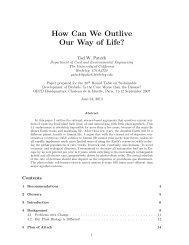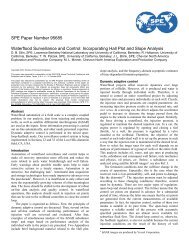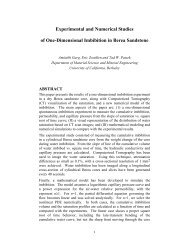The Disastrous Local and Global Impacts of Tropical Biofuel ...
The Disastrous Local and Global Impacts of Tropical Biofuel ...
The Disastrous Local and Global Impacts of Tropical Biofuel ...
You also want an ePaper? Increase the reach of your titles
YUMPU automatically turns print PDFs into web optimized ePapers that Google loves.
March 2007www.energytribune.comAMERICA: BURNING FOOD AS AUTO FUELET FocusArgentina’sLoomingEnergyCrunchPrice ControlsCrimp LatinAmerica’sBiggest GasProducer820 Gessner Rd. - Ste. 920 Houston, TX 77024Nationalizingthe Orinoco
ET Focus<strong>The</strong> <strong>Disastrous</strong> <strong>Local</strong><strong>and</strong> <strong>Global</strong> <strong>Impacts</strong> <strong>of</strong><strong>Tropical</strong> Bi<strong>of</strong>uel ProductionBy Lucas J. Patzek <strong>and</strong> Tad W. Patzekast November, Patricia A. Woertz, the CEO<strong>and</strong> president <strong>of</strong> Archer Daniels Midl<strong>and</strong>,outlined a new growth strategy for the foodprocessinggiant. ADM, America’s biggest producer<strong>of</strong> corn ethanol, will exp<strong>and</strong> its bi<strong>of</strong>uel production,moving into Brazilian sugarcane for ethanol <strong>and</strong> Indonesianpalm oil for biodiesel.Woertz, a former high-ranking <strong>of</strong>ficial atChevron, said ADM will get “long-term growth<strong>and</strong> returns by capitalizing on our globalstrengths <strong>and</strong> the changing dynamics <strong>of</strong> the globalenergy <strong>and</strong> food markets.”As ADM, one <strong>of</strong> the world’s largest food companies,seeks to increase pr<strong>of</strong>its, the continuingpush into the tropics by it <strong>and</strong> other bi<strong>of</strong>uel producerswill only accelerate a potential ecologicalcatastrophe. Vast tracts <strong>of</strong> Malaysian <strong>and</strong> Indonesianforest have already been lost, <strong>and</strong> the increasingdem<strong>and</strong> for palm oil for biodiesel willcause further losses <strong>of</strong> tropical forests in these<strong>and</strong> other equatorial countries.This deforestation will likely be devastating.And yet, despite the global push for bi<strong>of</strong>uels, thepotential damage – increased soil erosion, huge carbondioxide emissions, biodiversity loss, <strong>and</strong> desertification– is largely being ignored.Here in the U.S. there has already been amplediscussion about bi<strong>of</strong>uels in Brazil, so let us concentrateon Indonesia <strong>and</strong> the oil palm.<strong>The</strong> oil palm (Elaeis) is the most productive oilcrop in the world, with an average annual yield <strong>of</strong>3 to 4 tons <strong>of</strong> crude palm oil per hectare for majorproducer countries. While the soybean is currentlythe world’s leading source <strong>of</strong> vegetable oil, with 30percent <strong>of</strong> global vegetable oil consumption in 2004,the oil palm is a close second with 29 percent <strong>of</strong> themarket. <strong>The</strong> fruit <strong>of</strong> the oil palm consists <strong>of</strong> a kernel(seed) within a hard shell that is surrounded bya fleshy pulp, the mesocarp. Commercial palm oilis derived from this mesocarp. <strong>The</strong> palm kernel oilis different. <strong>The</strong>se two oils have distinct fatty acidcompositions <strong>and</strong> hence differing uses. Palm oil is aneven 50/50 split between saturated <strong>and</strong> unsaturatedfat, while palm kernel oil’s saturated/unsaturatedratio is 82/18. After oil from the kernal is extracted,a proteinaceous residue remains, palm kernel cake,which is a valuable animal feed.Traditionally, about 80 percent <strong>of</strong> palm oil is foredible use. Common food products made from palmoil <strong>and</strong> palm kernel oil include cooking oils, shortenings,vegetable ghee, margarines <strong>and</strong> spreads, <strong>and</strong>confectionery <strong>and</strong> non-dairy products. Palm oil hasseveral properties that contribute to a long shelf lifefor end products: it is resistant to oxidative deterioration,suffers lower polymer formation, <strong>and</strong> has vitaminE as a natural antioxidant. <strong>The</strong> oil, therefore,is particularly suitable for use in hot climates <strong>and</strong> asa frying fat in the snack <strong>and</strong> fast food industry. Asfor its non-edible use, it is a good raw material forproducing oleochemicals, fatty acids, fatty alcohols,glycerol, <strong>and</strong> other derivatives for the manufacture<strong>of</strong> cosmetics, pharmaceuticals, bactericides, <strong>and</strong> otherhousehold <strong>and</strong> industrial products.Palm Oil Fruit photo by M.J. SilviusMarch 2007 19
ET FocusBurning Peat Swamp photo by M.J. SilviusDem<strong>and</strong> in the 18th century persuaded Europeansto plant oil palm plantations. <strong>The</strong> first largeplantation was established in Indonesia around 1911,<strong>and</strong> can be traced back to four seedlings planted atBogor Botanical Garden. From these seedlings theDeli dura (thick-shelled) palms developed, with betterfruit composition <strong>and</strong> a larger proportion <strong>of</strong> mesocarpthan in African palms. Southeast Asia, <strong>and</strong> specificallyMalaysia, has dominated the industry eversince. Malaysia <strong>and</strong> Indonesia together currently accountfor 86 percent <strong>of</strong> global palm oil production <strong>and</strong>91 percent <strong>of</strong> its global exports. Malaysia produces42 percent <strong>and</strong> remains the leading exporter with 48percent <strong>of</strong> the world market. Indonesia produces 44percent <strong>of</strong> the world’s palm oil <strong>and</strong> is a close secondin exports, with 43 percent <strong>of</strong> the market.Indonesia is a far larger country than Malaysiawith a correspondingly larger work force, <strong>and</strong> the expectationis that Indonesia will eventually surpassMalaysia as an exporter. As long as there is political<strong>and</strong> economic stability, Indonesia will remain thelargest producer in the world.<strong>The</strong> present success <strong>of</strong> the oil palm industryin these two countries can be attributed to theirfavorable climatic conditions, well-established infrastructure,<strong>and</strong> an unsurpassed knowledge base,both in the oil’s actual production <strong>and</strong> in its upstream<strong>and</strong> downstream industries. Oil palm plantationsare being established at a rapid rate inseveral other Southeast Asian nations, includingThail<strong>and</strong>, the Philippines, <strong>and</strong> Papua New Guinea.However, by far the largest developments arefound in Indonesia. <strong>The</strong>se developments are chieflyfunded by Malaysians, although China, Europe,<strong>and</strong> the U.S. are also key players.<strong>The</strong> attention given to biodiesel by the U.S.<strong>and</strong> E.U. governments has spurred the dem<strong>and</strong> forpalm oil for biodiesel. <strong>The</strong> E.U. recently orderedthat 5.75 percent <strong>of</strong> all vehicle fuels come from renewablesources. <strong>The</strong> U.S. Internal Revenue Servicehas deemed oil palm as a feedstock for biodiesel,<strong>and</strong> therefore it is eligible for the biodiesel taxcredit <strong>of</strong> a penny per percent <strong>of</strong> biodiesel blendedwith petroleum diesel. <strong>The</strong>se moves by the world’sbiggest motor fuel markets have led to a surge <strong>of</strong>investment in Malaysian <strong>and</strong> Indonesian palm oilplantations. Indonesia’s largest plantation company,PT Astra Agro Lestari, has seen its shares jumpby about 80 percent over the past year.THE FIRES ARE HARD TO CONTROL ANDSPREAD EASILY TO ADJACENT FORESTS.In Indonesia, the oil palm plantations are owned<strong>and</strong> operated by many <strong>of</strong> the same companies that operatelogging, wood-processing, <strong>and</strong> pulp industries.(<strong>The</strong> Salim Group, the Raja Garuda Mas Group, <strong>and</strong>the Sinar Mas Group are all prime examples.) A naturalresult <strong>of</strong> this conjoining has been an increasein illegal <strong>and</strong> damaging l<strong>and</strong> use. A company with aplantation concession may only be interested in thel<strong>and</strong>’s timber. <strong>The</strong> trees will be cut down <strong>and</strong> hauledaway, no replanting effort will ensue, <strong>and</strong> the l<strong>and</strong>will be left deforested <strong>and</strong> degraded.Companies commonly set fires to clear l<strong>and</strong> forplantations. Besides being illegal in many countries,including Indonesia, the fires are hard tocontrol <strong>and</strong> spread easily to affect adjacent forests<strong>and</strong> communities. In 1997 <strong>and</strong> 1998 fires ragedthrough 6 percent <strong>of</strong> Indonesia, burning 11.7 millionhectares <strong>of</strong> l<strong>and</strong>. <strong>The</strong> majority <strong>of</strong> the fires occurredon plantation company l<strong>and</strong>, <strong>and</strong> threequarterswere oil palm plantations. <strong>The</strong> governmentaccused 176 companies <strong>of</strong> starting thesefires, <strong>of</strong> which 133 were oil palm plantation companies.Just 5 companies were actually taken tocourt <strong>and</strong> only one was penalized.<strong>The</strong> widespread tropical forest <strong>and</strong> peat firesin Indonesia during 1997, combined with the firesin Central <strong>and</strong> South America <strong>and</strong> in the borealregions <strong>of</strong> Eurasia <strong>and</strong> North America, emitted7.7 billion tons <strong>of</strong> carbon dioxide. <strong>The</strong> cumulativeemissions from these forest fires rival the world’stotal anthropogenic emissions. <strong>Tropical</strong> forest <strong>and</strong>peat burning in Indonesia has continued unabated.And these oil palm plantations can never sequesterback the carbon dioxide that is released inforest <strong>and</strong> peat burning.20 Energy Tribune
<strong>The</strong> results <strong>of</strong> all this forest clearing can beseen by looking at Indonesia’s carbon dioxideemissions. Indonesia is now the third-leading producer<strong>of</strong> carbon emissions after the U.S. <strong>and</strong> China,according to a recent study done by two Dutchentities, Wetl<strong>and</strong>s International, a non-pr<strong>of</strong>itagency, <strong>and</strong> Delft Hydraulics, a consulting firm.<strong>The</strong> study also found that degraded peatl<strong>and</strong>s inSoutheast Asia produce some two billion tons <strong>of</strong>carbon “which is equivalent to almost 8 percent <strong>of</strong>the total carbon dioxide emissions from fossil fuels.”It goes on to say that these carbon emissionsare a “major obstacle to meeting the aim <strong>of</strong> stabilizinggreenhouse gas emissions.”Beyond the problems that arise from forest clearing,the replacement <strong>of</strong> primary forest with a monocultureplantation is disastrous for biodiversity. A1969 study showed that primary forests in the tropicscontain 75 mammalian species, while disturbedforest, oil palm <strong>and</strong> rubber plantations, <strong>and</strong> scrubl<strong>and</strong>contain only 32, 13, <strong>and</strong> 11 respectively. Naturally,plant diversity is more severely affected by theplantations. Since oil palm plantations can only beestablished in equatorial countries, the most biologicallydiverse in the world, these issues hold particularweight. An examination <strong>of</strong> Indonesia will put thisinto context. Although Indonesia occupies 1.3 percent<strong>of</strong> the earth’s l<strong>and</strong> surface, it is home to 11 percent <strong>of</strong>the earth’s plant species, 10 percent <strong>of</strong> its mammalspecies, <strong>and</strong> 16 percent <strong>of</strong> its bird species.Following deforestation <strong>and</strong> the subsequentconversion to agriculture, soil erosion on steepmountain slopes in Indonesia can be 30 timeshigher than the nominal soil erosion in U.S. agriculture,10 tons per hectare.It is the sheer scale <strong>of</strong> the deforestation in manyequatorial nations that is most worrisome. Indonesiaagain is a prime example. Forty percent <strong>of</strong> the forestsextant in 1950 were cleared in the subsequent50 years. (In 1950 there were 162 million hectares <strong>of</strong>forest, <strong>and</strong> in 2000 there were 98 million hectares.)<strong>The</strong> isl<strong>and</strong> <strong>of</strong> Borneo has lost 80 percent <strong>of</strong> its primaryforest in the last 20 years. Official Indonesianstatistics state that up to 2.4 million hectares <strong>of</strong> forestare leveled each year. Since in the 1980s the averagewas 1 million hectares per year, it is clear thatthe rate <strong>of</strong> forest loss is skyrocketing. Deforestationcontinues to be an immense problem – <strong>and</strong> the recentbi<strong>of</strong>uel fervor has only made it worse.One <strong>of</strong> the major benefits touted by plantationcompanies is their substantial generation <strong>of</strong> employment,especially in rural areas, which in turn drivesrural development. Since oil palm plantations arecurrently less mechanized than other types, theyrequire a larger labor pool. For example, oil palmplantations employ about 1 person per 10 hectares.In comparison, the larger soy plantations in Brazilemploy an average <strong>of</strong> 1 worker per 200 hectares.A 20,000 hectare oil palm plantation would thusemploy 2,000 people, while the same size soybeanplantation would only employ 200.It is possible, however, that such claims <strong>of</strong> increasedemployment are a disingenuous measure forcommunity improvement. Oil palm plantations, likeall other tropical plantations, exist in the world’smost biologically diverse terrestrial regions, onesthat have supported human communities for a longtime. In fact, human beings are tropical animalswho originated from these regions, so it is safe to saythat as a species we have more experience creating alivelihood from tropical forests than from any otherhabitat. <strong>The</strong> loss <strong>of</strong> these forests to giant monocultureplantations creates a previously non-existentdependency on external factors. A local communitymay no longer be self-sufficient, for instance havingplentiful quantities <strong>of</strong> local fruits, vegetables, bushmeat,<strong>and</strong> lumber, <strong>and</strong> find themselves at the mercy<strong>of</strong> market forces to provide work <strong>and</strong> wages, importedfoodstuffs, <strong>and</strong> housing materials. As circumstancehas shown, this pattern <strong>of</strong> stripping away acommunity’s once viable subsistence lifestyle <strong>and</strong>replacing it with an alien wage-based existence isdetrimental <strong>and</strong> debilitating.Communities once considered poor by Westernst<strong>and</strong>ards <strong>of</strong>ten become utterly impoverished bytheir forced dependence on a market economy, whichholds no real niche for them other than as cheap labor.<strong>The</strong>re are factors beyond a mere sustenance autonomythat must be considered as contributing toa quality <strong>of</strong> life. One must also take into account apeople’s ancient cultural <strong>and</strong> spiritual ties, as wellas their legal rights to their l<strong>and</strong>.Source data for graph: Impact <strong>of</strong> oil palm plantation estabishment on greenhouse gas balance by Germer, J. <strong>and</strong> Sauerborn, J.<strong>The</strong> <strong>Impacts</strong> <strong>of</strong> <strong>Tropical</strong> Bi<strong>of</strong>uel Production - March 2007 21









